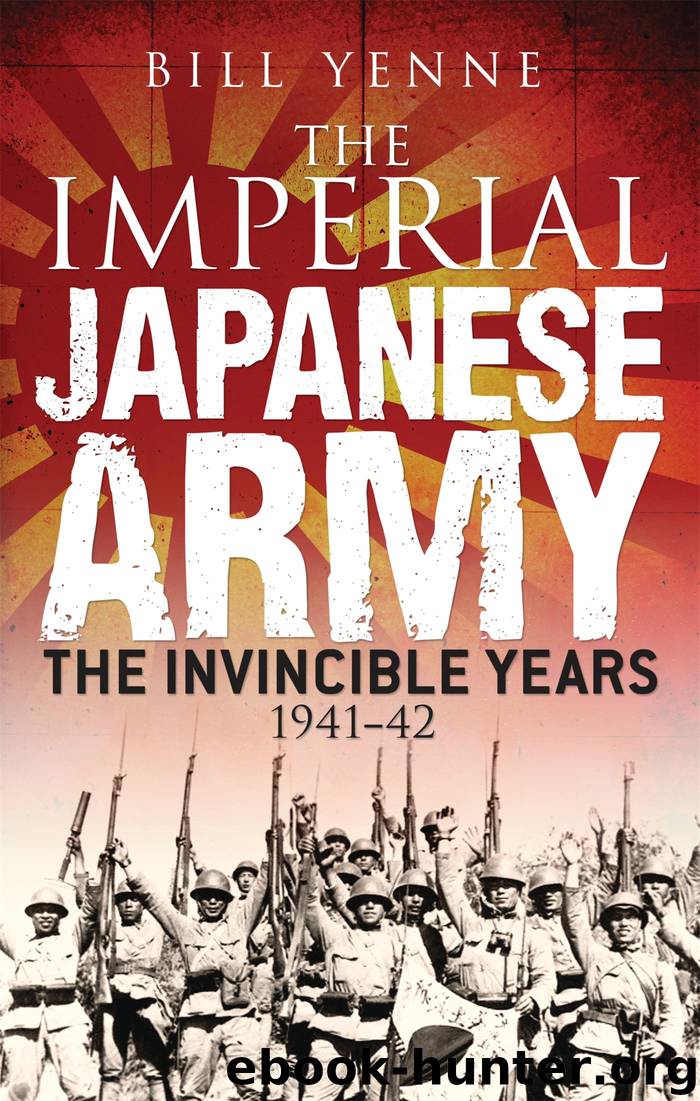The Imperial Japanese Army by Bill Yenne

Author:Bill Yenne [Yenne, Bill]
Language: eng
Format: epub
Tags: Bill Yenne the Imperial Japanese Army: The Invincible Years 1941–42
ISBN: 9781782009825
Publisher: Osprey Publishing
Published: 2017-05-17T04:00:00+00:00
CHAPTER 17
WAR COMES TO BURMA
Burma was a keystone on the strategic map of Southeast Asia. With China to the north, Thailand to the east, and India, the crown jewel of the British Empire, to the west, it was a crossroads of hugely important centers of gravity in the geopolitics of East Asia.
For China, Burma was a lifeline. In 1937, with major Chinese ports under Japanese control, China, in cooperation with Burma, began building the Burma Road, a 700-mile, largely unpaved highway that ran across the rugged mountains of northern Burma, connecting Burma’s port of Rangoon with the Chinese city of Kunming, by way of the Burmese city of Lashio. Utilizing the labor of an estimated 200,000 workers, the Burma Road had opened in 1938. Most of China’s military supplies came via this precarious thoroughfare.
For Thailand, Burma was a buffer between itself and the British center of gravity in India. For the British, Burma was India’s doorstep. For these reasons, Burma was of utmost importance strategically to all three.
Japan’s desire to occupy this Southeast Asian keystone was directly associated with Burma’s importance to China and the British Empire. There was some petroleum production at Yenangyaung in central Burma, but by comparison to that of the Dutch East Indies, Burma’s oil fields were inconsequential. Japan wanted Burma the way a chess player desires to place a particular piece on a particular square. The value of Burma was not inherent, but lay in its position relative to other squares on the board.
Because of their ongoing war with China, the Japanese wished to cut the Burma Road supply route. Britain feared that Burma, if captured by the Japanese, would be a stepping stone for an invasion of India itself. A few weeks earlier, such a prospect had been absurd. However, after Tomoyuki Yamashita’s apparently effortless conquest of impregnable Singapore, this could not be ruled out. In Allied circles, there was a great and genuine fear that the Germans would capture the Suez Canal and drive eastward across Iraq and Iran – where Axis sympathies ran high – and link up with the Japanese somewhere in India, where anti-British sympathies simmered.
In the propaganda of the Greater East Asia Co-Prosperity Sphere, when mention was made of “Asia for Asiatics,” Indians were included. In the manual given to IJA troops, Read This Alone: And The War Can Be Won, mention was made about the liberation of “350 million Indians ruled by 500,000 British,” and the independence movement in India was sufficiently robust that the British worried about what would happen if the Japanese crossed into India branding themselves as liberators. Once a backwater to regional affairs, Burma was suddenly a precious regional crux.
Throughout the centuries, Burma had evolved and dissolved, alternating between empires and disparate warring states with blurred borders. It is named for the Bamar people, who are the dominant ethnic group (around seven out of ten) in the country. The name “Myanmar,” in use officially since 1989, though not universally recognized, is also derived from the term Bamar.
Download
This site does not store any files on its server. We only index and link to content provided by other sites. Please contact the content providers to delete copyright contents if any and email us, we'll remove relevant links or contents immediately.
| Africa | Americas |
| Arctic & Antarctica | Asia |
| Australia & Oceania | Europe |
| Middle East | Russia |
| United States | World |
| Ancient Civilizations | Military |
| Historical Study & Educational Resources |
The Sympathizer by Viet Thanh Nguyen(4103)
The Rape of Nanking by Iris Chang(4030)
World without end by Ken Follett(3352)
Ants Among Elephants by Sujatha Gidla(3283)
Blood and Sand by Alex Von Tunzelmann(3067)
Japanese Design by Patricia J. Graham(3012)
City of Djinns: a year in Delhi by William Dalrymple(2441)
Foreign Devils on the Silk Road: The Search for the Lost Treasures of Central Asia by Peter Hopkirk(2393)
Inglorious Empire by Shashi Tharoor(2349)
The Queen of Nothing by Holly Black(2339)
India's Ancient Past by R.S. Sharma(2315)
In Order to Live: A North Korean Girl's Journey to Freedom by Yeonmi Park(2306)
Tokyo by Rob Goss(2299)
India's biggest cover-up by Dhar Anuj(2255)
Tokyo Geek's Guide: Manga, Anime, Gaming, Cosplay, Toys, Idols & More - The Ultimate Guide to Japan's Otaku Culture by Simone Gianni(2248)
The Great Game: On Secret Service in High Asia by Peter Hopkirk(2237)
Goodbye Madame Butterfly(2168)
Batik by Rudolf Smend(2014)
Living Silence in Burma by Christina Fink(1992)
